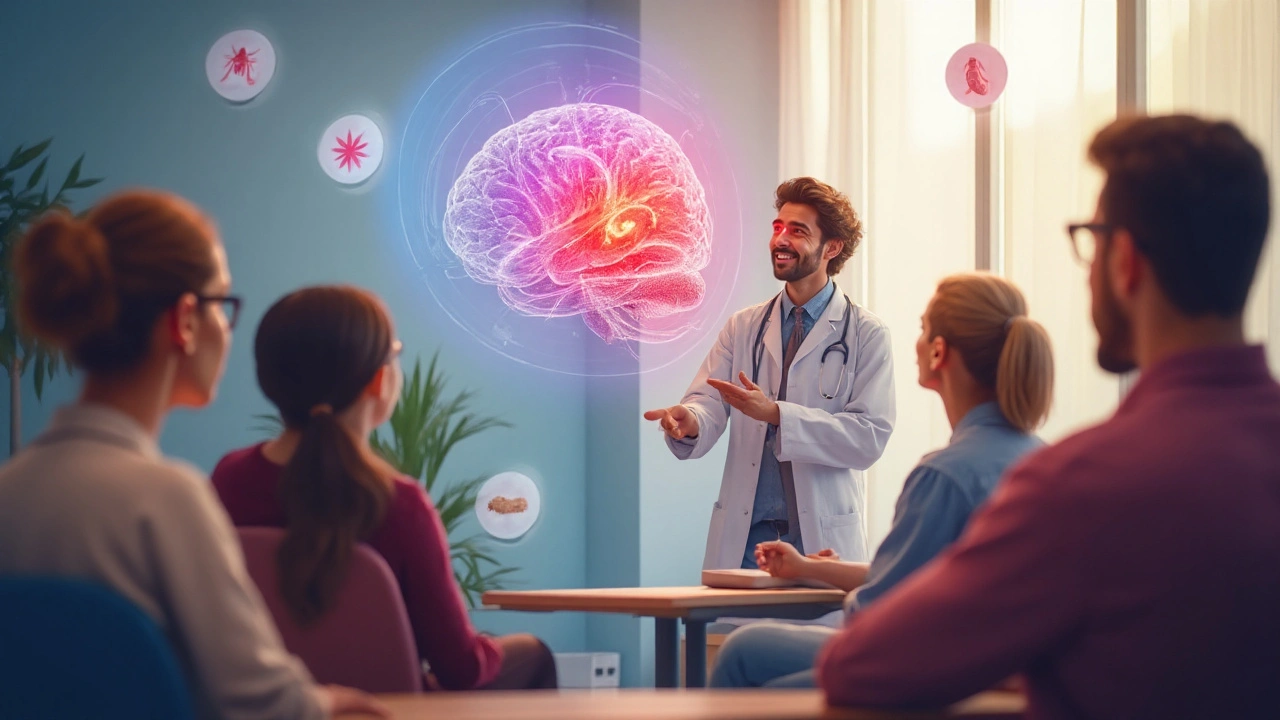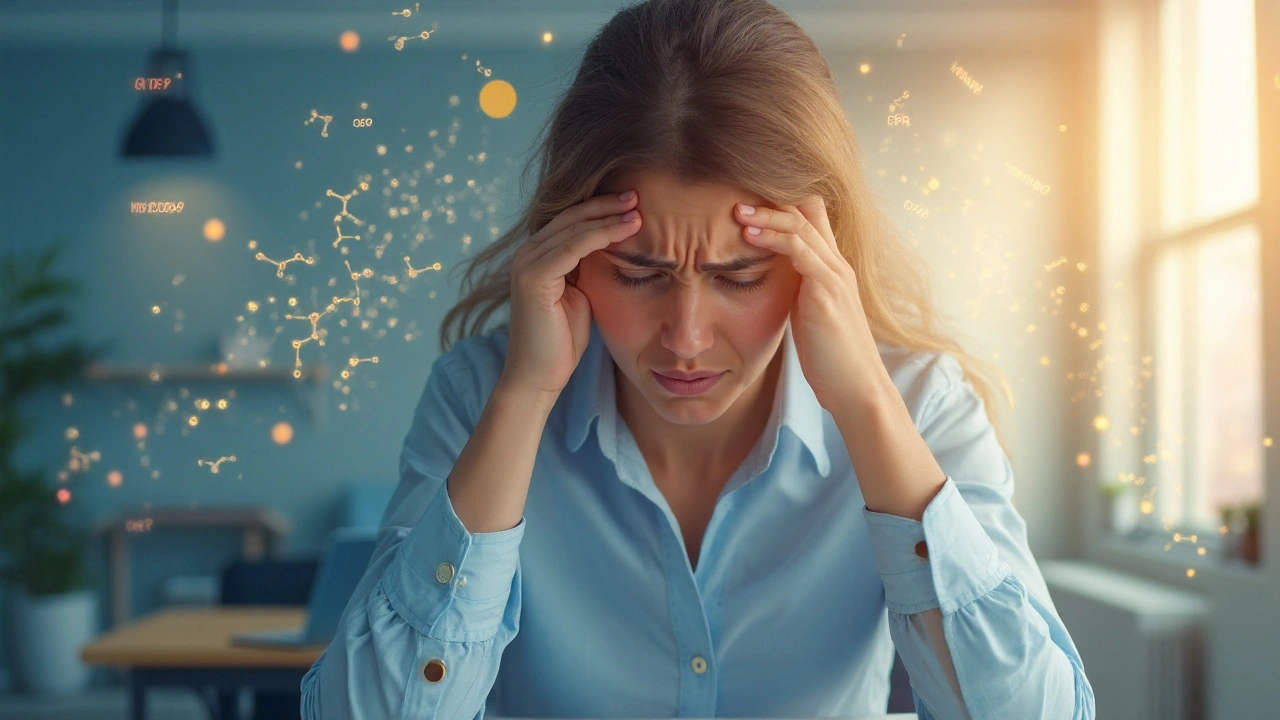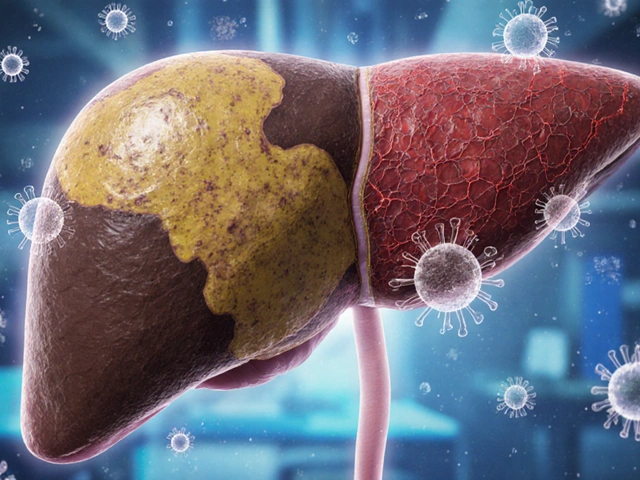Allergic disorders are immune‑mediated conditions that cause symptoms such as sneezing, itching, and swelling when the body overreacts to harmless substances. When you combine migraine - a neurovascular headache disorder marked by throbbing pain, nausea, and light sensitivity - the result can feel like a perfect storm in the brain. Researchers now agree that the two share more than coincidence; they intersect at biochemistry, nerve pathways, and even lifestyle triggers. This article untangles those connections, offers evidence‑based strategies, and points you toward the next steps in managing both conditions.
Why the Overlap Matters
Studies from the European Headache Federation (2023) show that up to 30% of chronic migraine sufferers also report a diagnosed allergic disorder, compared with 15% in the general population. That gap suggests a real comorbidity rather than random chance. For patients, recognizing the link can shorten the diagnostic odyssey, prevent unnecessary medication trials, and improve quality of life.
Key Biological Players
Several molecules act as bridges between allergy and migraine. Below are the most studied.
- Histamine is a biogenic amine released by mast cells during allergic reactions. It binds to H1-H4 receptors, causing vasodilation, increased vascular permeability, and pain sensitisation. High plasma histamine levels have been recorded during migraine attacks, implying a shared pathway.
- ImmunoglobulinE (IgE) is the antibody type that initiates classic allergic cascades. Elevated IgE correlates with more frequent migraine days in a 2022 cohort of 1,200 patients.
- CGRP (calcitonin gene‑related peptide) is a neuropeptide released from trigeminal nerves. It causes potent vasodilation and is a primary target of newer migraine drugs. Histamine can provoke CGRP release, creating a feedback loop that amplifies headache pain.
- Serotonin regulates vascular tone and pain perception. Both allergic inflammation and migraine attacks can deplete central serotonin, contributing to the classic aura and mood changes.
- Inflammatory cytokines such as tumour necrosis factor‑α (TNF‑α) and interleukin‑6 (IL‑6) surge during allergic flare‑ups and have been found elevated in the cerebrospinal fluid of migraineurs during attacks.
Neuro‑Immune Pathways: From Nose to Head
The trigeminal nerve is the main conduit that links peripheral inflammation to central pain processing. When allergens activate mast cells in the nasal mucosa, histamine and cytokines travel via perivascular spaces to the trigeminal ganglion. This stimulates CGRP release, which then dilates meningeal vessels and triggers the classic migraine cascade.
Think of it as a telephone line: an allergic call‑in at the nose is instantly forwarded to the brain’s pain centre, causing a “headache” ringtone.
Shared Triggers: What Sets Off Both Conditions?
Identifying overlapping triggers can be a game‑changer for patients. Common culprits include:
- Seasonal pollen - peaks in histamine and often matches migraine “weather‑related” patterns.
- Food allergens - aged cheese, red wine, and chocolate contain histamine or can provoke IgE‑mediated reactions.
- Environmental irritants - strong perfumes, cigarette smoke, and cleaning agents irritate nasal passages and can activate the trigeminal system.
- Stress - releases cortisol, which modulates both mast‑cell degranulation and trigeminal excitability.
Keeping a detailed diary that records both allergy symptoms and headache timing often reveals personal patterns that would otherwise stay hidden.
Clinical Implications: Diagnose and Treat Smartly
When a patient presents with recurrent headaches, a focused allergy history can reveal treatable triggers. Conversely, chronic sinusitis patients reporting migraine‑like pain should be screened for migraine using the ICHD‑3 criteria.
Therapeutic options fall into three categories:
- Allergy‑targeted therapies: Antihistamines (second‑generation H1 blockers such as cetirizine), nasal corticosteroids, and allergen‑specific immunotherapy have shown modest reductions in migraine frequency (average 1.2 fewer migraine days per month in a 2021 double‑blind trial).
- Migraine‑specific drugs: CGRP monoclonal antibodies (e.g., erenumab) and triptans remain first‑line for acute attacks. Some clinicians combine them with antihistamines when a clear allergic trigger is identified.
- Lifestyle and avoidance: Air‑filter use during pollen season, hypo‑allergenic bedding, and dietary elimination can cut both symptom streams.

Comparison: Antihistamine vs Triptan for Headache Relief
| Attribute | Antihistamine (e.g., cetirizine) | Triptan (e.g., sumatriptan) |
|---|---|---|
| Primary action | Blocks H1 histamine receptors | Serotonin‑3 (5‑HT1B/1D) agonist |
| Onset of relief | 30‑60min (often slower) | 10‑30min (rapid) |
| Best for | Headaches linked to allergic flare‑ups | Typical migraine attacks without clear allergy trigger |
| Side‑effects | Dry mouth, mild drowsiness | Chest tightness, serotonin syndrome (rare) |
| Long‑term use | Generally safe, low tolerance | Risk of medication‑overuse headache |
When histamine spikes are the main driver, an antihistamine can prevent the migraine before it starts. For established attacks, triptans remain the gold standard, but combining them with a short‑acting antihistamine may boost response in selected patients.
Managing the Dual Diagnosis: A Practical Toolkit
- Start a symptom journal: Record pollen counts, foods, weather, and headache timing. Patterns emerge after 2-4 weeks.
- Test for IgE‑mediated allergies: Skin‑prick or specific‑IgE blood tests help pinpoint triggers you can avoid.
- Trial a second‑generation antihistamine: Begin with the lowest dose at symptom onset; monitor for reduction in headache intensity.
- Consult a neurologist if attacks exceed three per month despite allergy control - they may prescribe a CGRP antagonist.
- Implement environmental controls: HEPA filters, hypo‑allergenic pillow covers, and regular cleaning reduce indoor allergen load.
Related Concepts and Emerging Research
Beyond the core pathway, several adjacent topics deserve attention:
- Neurogenic inflammation: The release of CGRP and substanceP from sensory nerves amplifies both allergic swelling and migraine pain.
- Blood‑brain barrier permeability: Histamine can loosen tight junctions, potentially allowing peripheral inflammatory mediators to affect central neurons.
- Gut‑brain‑allergy axis: Dysbiosis may increase systemic histamine, linking food intolerance, allergy, and migraine.
Future trials aim to combine oral antihistamines with CGRP monoclonal antibodies, hoping to cut migraine days by half in patients with confirmed allergic comorbidity.
Take‑Away Summary
Understanding that allergic disorders and migraines share histamine‑driven pathways equips patients and clinicians to treat both more efficiently. By mapping triggers, using targeted medication, and embracing lifestyle adjustments, many can break the cycle of overlapping attacks.
Frequently Asked Questions
Can allergies cause migraines?
Yes. Allergic reactions release histamine and cytokines that can stimulate the trigeminal nerve, a key driver of migraine attacks. People with seasonal allergies often notice a spike in headache frequency during pollen peaks.
Are antihistamines effective for treating migraine?
Antihistamines are not a primary migraine treatment, but they can help when a migraine is triggered by an allergic flare‑up. Second‑generation antihistamines (cetirizine, loratadine) are preferred due to fewer sedative effects.
What is the role of CGRP in allergic‑migraine connections?
CGRP is a neuropeptide that widens blood vessels and transmits pain signals. Histamine can trigger CGRP release from trigeminal nerves, creating a loop that intensifies both allergic swelling and migraine pain. CGRP‑targeted drugs have shown efficacy even in patients with high histamine levels.
Should I get tested for food allergies if I have chronic migraines?
If you notice that certain foods consistently precede a headache, a food‑specific IgE test or an elimination diet under professional guidance can clarify whether a true allergy or a histamine‑rich food is the culprit.
Is there a risk of medication‑overuse headache when combining antihistamines and triptans?
Antihistamines have low risk of causing rebound headache, but triptans can lead to medication‑overuse if taken more than ten days per month. Always discuss combined use with a healthcare provider to avoid over‑medication.






April Rios
When you stare at the cascade of histamine‑driven pathways, it feels like you’re peering into the very micro‑cosmos of human perception; every sneeze is a tiny rebellion, every migraine a thunderous echo of that same rebellion. The philosophical twist is that the body’s defense mechanisms double‑handedly become its own tormentors. In other words, the immune system writes its own love‑letter to the brain, only to have the brain read it as a ransom note. This duality reminds me of the classic paradox: what protects can also poison.
byron thierry
While the article presents a thorough synthesis of immunological and neurological data, one must also consider the epidemiological nuances that differentiate regional allergen profiles. It is commendable that the authors highlighted the role of second‑generation antihistamines, yet a comparative analysis with older agents would further enrich the discourse. Moreover, the clinical implications for preventive strategies are indeed promising, and I look forward to future longitudinal studies. Friendly reminder: always align treatment plans with patient‑specific trigger histories.
bob zika
Indeed, the intersection of IgE‑mediated responses, histamine release, and CGRP activation is a complex ballet, one that warrants meticulous attention, especially when designing multimodal therapeutic regimens, which must balance efficacy with safety, and consider patient comorbidities, as well as pharmacodynamic interactions, thereby ensuring an optimal clinical outcome.
M Black
Yo, if you’ve ever noticed your head pounding right after a pollen blitz, it’s not just a coincidence – that histamine rush is lighting up your trigeminal nerve like a fireworks show 🤘 so grab that non‑sedating antihistamine before the storm hits and you’ll probably dodge a migraine attack
Sidney Wachira
Drama alert! The moment those mast cells pop open and unleash a tsunami of histamine, your brain thinks it’s under siege, and boom – migraine city! 🌪️ It’s like the body’s own horror movie, where the villain is an invisible allergen and the hero is a tiny pill you’ve probably ignored. Trust me, you don’t want to be the unsuspecting victim.
Aditya Satria
While the vivid depiction captures attention, it is essential to ground the narrative in evidence‑based practice; antihistamines, particularly second‑generation agents, have demonstrated modest yet reproducible reductions in migraine frequency when used prophylactically. Patients should be guided to initiate therapy during identifiable allergen exposure periods, monitor symptom trajectories, and adjust dosages under clinical supervision. This structured approach maximizes benefit while minimizing unnecessary medication burden.
Jocelyn Hansen
Great points! 😄 Adding to that, many patients report that keeping a simple diary-just jotting down pollen counts, food intake, and headache timing-creates a clear picture of personal triggers. It’s amazing how a few minutes each day can empower you to make proactive adjustments, like swapping out a high‑histamine cheese for a fresher alternative. Consistency is key!
Joanne Myers
Indeed, the paradox of protection becoming pain offers a compelling lens through which to view comorbidity; appreciating this nuance can refine diagnostic criteria and therapeutic choices.
rahul s
Listen, folks-if you’re still blaming “just stress” for your headaches while walking past a field of blooming ragweed, you’re missing the obvious! The nation’s elite know that histamine is the hidden puppet master, pulling the strings of both sneezes and throbbing skulls. So stop the wishful thinking, grab a proper antihistamine, and shut that sneaky antagonist down before it hijacks your brain.
Julie Sook-Man Chan
Keeping a symptom diary can reveal patterns you might otherwise overlook.
Amanda Mooney
Indeed, systematic documentation of allergic episodes alongside migraine onset times provides invaluable data for personalized management strategies.
Mandie Scrivens
Oh sure, because ignoring the obvious link between histamine and head pain has always been the pinnacle of modern medicine.
Natasha Beynon
Absolutely, and the good news is that simple interventions like HEPA filters and non‑sedating antihistamines can make a measurable difference without overcomplicating treatment plans.
Cinder Rothschild
Understanding the intricate dance between allergic inflammation and migraine genesis demands more than a cursory glance at a textbook diagram; it calls for an appreciation of the body's symphonic response to external provocations. First, mast cells nestled within the nasal mucosa awaken under the influence of airborne allergens, disgorging histamine in a cascade that reverberates through nearby vascular structures. This histamine surge not only dilates blood vessels, easing the passage of immune cells, but also sensitizes the nearby trigeminal nerve endings, priming them for heightened excitability. As the trigeminal ganglion receives this amplified signal, it releases calcitonin gene‑related peptide, a potent vasodilator that further expands meningeal vessels and intensifies nociceptive signaling. The resulting feedback loop creates a situation where each sneeze or itching episode can translate into a throbbing headache that radiates across the forehead. Moreover, cytokines such as interleukin‑6 and tumor necrosis factor‑α accompany the histamine wave, amplifying the inflammatory milieu both peripherally and centrally. These cytokines are known to cross the blood‑brain barrier when it becomes more permeable, a condition that histamine itself can exacerbate by loosening endothelial tight junctions. Once within the central nervous system, they can influence glial activation, further propagating pain pathways. Concurrently, serotonin levels may dip as the body diverts tryptophan towards inflammatory processes, removing a natural brake on pain perception. This biochemical imbalance explains why patients often report mood changes alongside their physical symptoms. Lifestyle factors such as stress and poor sleep can magnify these biochemical perturbations, creating a perfect storm that lowers the threshold for migraine attacks. The practical implication is that targeting any node in this network-whether through antihistamines that block H1 receptors, nasal corticosteroids that dampen mast cell activation, or CGRP monoclonal antibodies that interrupt downstream signaling-can yield therapeutic benefit. Clinical studies have shown that patients who adopt a multi‑pronged approach, combining allergen avoidance with migraine‑specific prophylaxis, experience a statistically significant reduction in migraine days per month. Finally, the empowerment of patients through meticulous self‑monitoring-tracking pollen counts, dietary triggers, and headache timing-provides the data needed to fine‑tune this therapeutic orchestra, ultimately restoring harmony between immune function and neural stability.
Oscar Brown
The exposition presented above elegantly synthesizes the pathophysiological cascade linking histaminergic activity to trigeminal sensitisation, yet it behooves the practitioner to scrutinise the methodological rigour of the cited investigations, particularly with regard to sample size adequacy, blinding protocols, and the statistical handling of confounding variables such as concurrent analgesic use, comorbid psychiatric disorders, and seasonal variability in allergen exposure; only through such meticulous appraisal can we discern whether the observed reductions in migraine frequency are attributable to the antihistaminic intervention per se or to ancillary lifestyle modifications inadvertently introduced alongside the pharmacologic regimen; furthermore, the potential for pharmacodynamic interactions between second‑generation antihistamines and emerging CGRP‑targeted monoclonal antibodies warrants comprehensive pharmacovigilance, especially in polypharmacy contexts common among patients with chronic migraine and allergic rhinitis, wherein hepatic enzyme induction or inhibition could alter drug plasma concentrations, thereby modulating efficacy and safety profiles; consequently, a stratified, patient‑centred approach that integrates biomarker assessments-such as serum IgE titers, histamine metabolite levels, and CGRP plasma concentrations-with individualized trigger avoidance strategies may represent the optimal paradigm for attenuating the dual burden of allergy‑induced migraine.
Tommy Mains
If you’re dealing with both allergies and migraines, start with the basics: take a non‑sedating antihistamine when your symptoms flare, keep a simple diary, and talk to your doctor about adding a migraine preventive if headaches persist.
Alex Feseto
It would be remiss not to acknowledge that the aforementioned regimen, while ostensibly pragmatic, may insufficiently address the underlying neurovascular dysregulation inherent to migraine pathophysiology, thereby necessitating the incorporation of advanced therapeutics such as CGRP antagonists to achieve comprehensive symptom amelioration.
vedant menghare
Having perused the comprehensive overview, I am inclined to suggest that a multidisciplinary approach-encompassing allergists, neurologists, and perhaps even dietitians-will afford the most robust platform for dissecting patient‑specific trigger matrices and instituting tailored prophylactic strategies.
Kevin Cahuana
Totally agree! A team effort makes the whole thing way easier to manage, and sharing notes between specialists can cut down on trial‑and‑error meds fast.
Danielle Ryan
This whole histamine‑migraine link is just another government conspiracy!!!